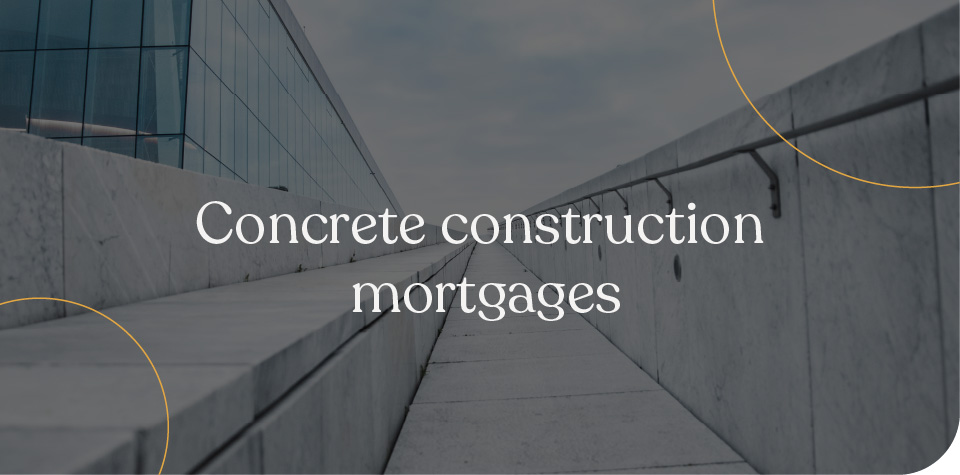
Concrete construction mortgages – Lenders, rates and how to get a mortgage on a concrete build property
A mortgage on a concrete house is challenging to get. A concrete construction house is a non-standard build type. This means that any concrete construction properties falling within this category could be riskier and may be harder to insure or resell.
This guide will help you understand the basics of mortgages for concrete houses. You may also want to consult a professional, specialist mortgage broker specialising in non-standard construction houses built from non-standard materials.
Enquire below to speak with our mortgage brokers, who the FCA regulates. We have a few mortgage providers lending for concrete construction houses.
Get started online
Is it possible to get a mortgage for a concrete-construction property?
It is possible. Every lender will offer a mortgage to you for a non-standard property or concrete house. It is unlikely that your application will be approved if the lender deems the property unreliable as security for the loan amount requested.
Mortgage lenders are more concerned about non-standard constructions than the property’s structural integrity. They also consider the possibility of future problems if the property is sold.
In the event of repossession, lenders will consider how difficult it is to resell. Only formal valuation will confirm the property’s mortgage ability.
There may be some caveats to approval, including a higher deposit or higher interest rates to offset the perceived risk.
These factors may make it harder to obtain a mortgage for a concrete property. However, specialist lenders are available who can deal with non-standard mortgage applications. Our advisors know who they are.
Get started online
Concrete construction property mortgages are more difficult to obtain.
In the UK, many homes are made of precast reinforced concrete (PRC). They date back to the 1950s, when affordable, quick housing became necessary after the Second World War.
These properties were first discovered in the 1980s. The eroding steel columns threatened the structural integrity of concrete buildings.
Many lenders began refusing mortgages on concrete properties because they were not considered acceptable security for home loans.
Many properties in the PRC will have been “repaired”. These properties (repaired in PRC) are more attractive to lenders than properties that have not been fixed.
There are many types of concrete construction methods that you should be aware of
Wimpey No-fines is one of the most well-known examples of this. It is a construction method that uses a series of housing designs to mass-produce social housing.
Although some lenders will approve a Wimpey No Fines concrete mortgage, there are instances when these properties could be considered riskier.
You may also consider other methods or well-respected PRC construction companies that could limit your chances of getting a mortgage.
Cornish Units
Cornish Units are one of the most famous types of temporary PRC constructions. They were primarily located in Cornwall and the surrounding areas following the Second World War.
There are two types of Cornish units. Type 1 has PRC panel walls on the ground floor, while Type 2 uses mansard roofing with nearly vertically clad tiles and timber trusses. Type 2 Cornish units generally have reinforced concrete exterior walls precast over both storeys.
Woolaway Construction builds
Woolaway Construction, another popular post-war housing option, built various PRC houses out of concrete panels and frames. Woolaway houses were mainly semi-detached, terraced two-storey houses or detached bungalows. Getting a mortgage for a bungalow made from Woolaway can often be challenging.
Dorran constructions
R.G. Hull was a Hull-based construction company. Tarran, the Tarran Prefab’s builder, used the Pillars of Perth method to create the Dorran House. These bungalows are most often made from precast panels.
Reema Construction Homes
Reema construction was developed in the late 1940s. It is still in use today. Reema Hollow Panel is one type, and Reema Conclad is the other. Although lenders consider Reema Conclad a less risky investment, obtaining a mortgage for any type of Reema Construction is still possible.
Orlit concrete homes
Erwin Katona designed the Orlit house design. They were built in the UK as a cheap and quick solution after the war. However, many of them have been demolished or require extensive repairs before lenders will approve a mortgage.
Construction of houses in Airey
The creation of the PRC Airey house structures was attributed to Sir Edwin Airey. These prefab homes were built in the UK following the Second World War. They are made of concrete columns reinforced by metal tubing. This material is believed to have been reused from military vehicles.
Unity PRC homes
Unity PRC homes were built mainly in the 1950s as semi-detached, terraced or two-storey homes. Unity PRC homes used asbestos-based roofing initially, and the usual concrete critical, and steel beam issues are common to PRC properties.
Wates Group PRC
Wates Construction created another popular type of housing in the PRC after World War II. These homes were again built to alleviate the nation’s housing shortage. However, they are now considered “defective housing” due to corrosion issues in concrete and steel.
Hawksley Constructions
They are made of PRC beams and have a brick outer shell, Hawksley PRCs could easily be mistaken as a traditional brick house. Many major high-street lenders will accept various PRC Homes-approved repair plans for Hawksley homes.
Get started online
Whitson Fairhurst Homes PRC
Whitson-Fairhurst also produced several PRC houses between 1940 and 1959 as a quick solution to the housing shortage that arose after World War II. These properties are widespread in Scotland.
Mortgage options for concrete construction
While lenders may not be able to lend money on a concrete home, they will consider non-standard build requests if there is no risk to the property. One lending option could be a prefab house mortgage; however, a surveyor must assess the property before you buy.
Alternatively, you might consider fixing the property to make it easier to mortgage. Concrete blocks and panels must be replaced by “standard” brick.
Although it can be time-consuming and costly, the property’s value may increase after the work is completed. This could offset the cost of rebuilding. You may also be able to get better rates and a more comprehensive selection of lenders if you decide to renovate. This will help you save money over the long term.
How to get a mortgage for a concrete ex-council home
It is possible. However, ex-council properties can sometimes be challenging to obtain a mortgage independently. It is highly recommended to seek specialist advice from a broker specialising in concrete construction.
Get started online
The mortgage lender may have additional considerations if the property you are looking to purchase is an ex-council property.
- The property is freehold or leasehold. Most leasehold properties are short-term leaseholds. Your chances of getting a leasehold mortgage might be reduced if the lease has only a few months left.
- The design and size of the property: You might have a smaller selection of lenders if the concrete property’s kitchen is not separate from the main living space or the property is less than a specific size. These are two examples of designs that lenders may avoid.
- Is it a high-rise property: This type of property can cause lenders to be cautious?
Other factors that impact eligibility
Lenders will decide if you are eligible for a concrete-construction mortgage. This is in addition to the property-specific factors discussed in this article. They use the following factors.
- The ratio of loan to value:
The greater the deposit, the better. Lenders may require this if you have a non-standard property, such as a concrete house. - Income and affordability
Non-standard mortgage providers limit their lending to x4 of your salary. Others may lend x5 or x6. You will have to pay significant outgoings, such as debts or dependent children. - Type of employment:
A specialist lender might be necessary if you are looking for a self-employed mortgage or want to apply for a mortgage that includes commissions or bonuses. - Age:
Non-standard mortgage providers may not lend to people over 75. Others are over 85, and a few others have no upper age limits. There are, however, specific mortgages that are geared toward retirement borrowers. - Credit history
Lenders are less likely to lend money to people with poor credit histories, mainly if the mortgage is for high-risk properties. Lenders who consider you might charge higher interest rates and limit the amount they will lend you. They might also require a higher LTV. Some specialists can offer favourable rates to these clients, even though they may have poor credit.
Talk to an expert
The chances of getting rejected or having unfavourable rates are higher when you buy a concrete property.
There is a way to tip the odds in your favour and ensure you find the right lender for you. Talk to a broker when you click the link below that specialises in a non-standard concrete construction house.
Get started online
It can be hard to find a mortgage advisor with this expertise level. However, we offer this service for free, so you don’t have any cost.
We provide mortgage advice free of charge for a non-standard construction property and every other residential and commercial mortgage.
Get started online